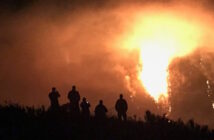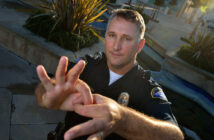The voice crackles over the hand-held radio.
“We are clear for doors.”
It’s 5:30 p.m. on a recent weekday.
Over the next 90 minutes or so, a near-capacity crowd will pour into Honda Center in Anaheim to catch a 7 p.m. hockey game between the Anaheim Ducks and the Arizona Coyotes.
Joining about 1,000 employees, the spectators will transform Honda Center into a teeming mini-city for about five hours.
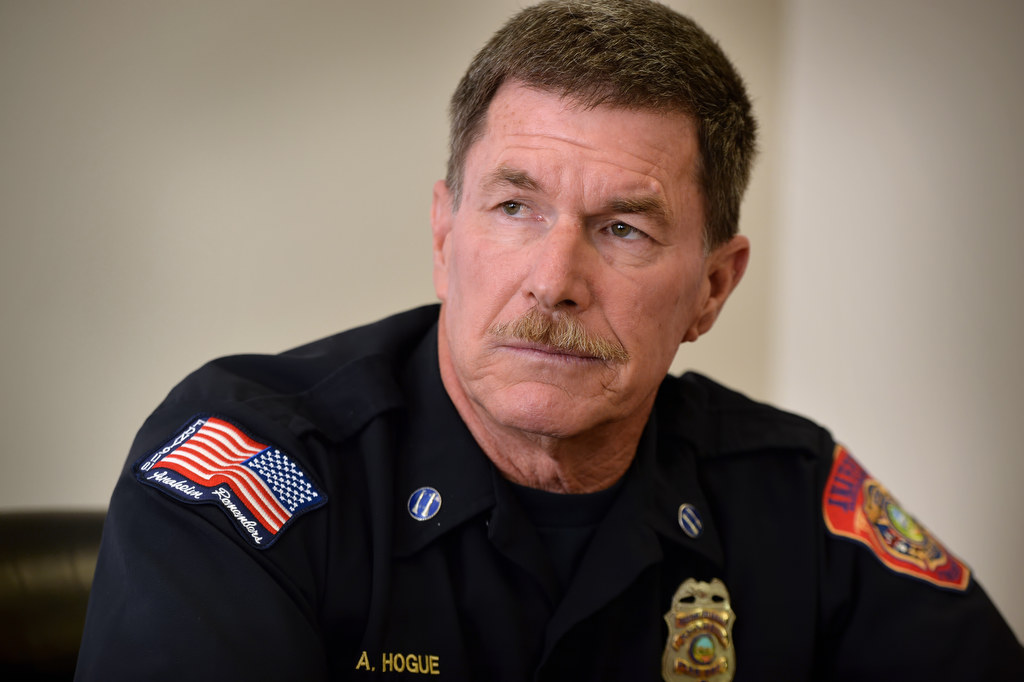
Acting Fire Marshal Allen Hogue of Anaheim Fire & Rescue talks about his experiences and the importance of fire prevention.
Photo by Steven Georges/Behind the Badge OC
Soon after that, all will be quiet again.
Most folks don’t think much about what goes on behind the scenes when they visit Honda Center for a hockey game, concert or other event.
For Allen Hogue and other members of his team at Anaheim Fire & Rescue, thinking about these things — such as making sure exits are clear, that vendor kiosks are properly positioned to avoid bottlenecks in the concourse, that fire alarms and sprinklers are working — is their job.
“We want them (the public) to come here and have a happy experience, get home safely and come back,” says Hogue, acting fire marshal at AF&R who specializes in what the agency calls “community risk reduction.” This means inspecting buildings as they are being built to ensure fire codes are being met, checking existing buildings for the same, and staffing major events like hockey games to make sure things go off seamlessly.
To ensure things do go off seamlessly, fire inspectors who report to Hogue work closely with officials like Quinn Mackin, director of events at Anaheim Arena Management, which oversees management of Honda Center, from booking all events to running the food and beverage operations.
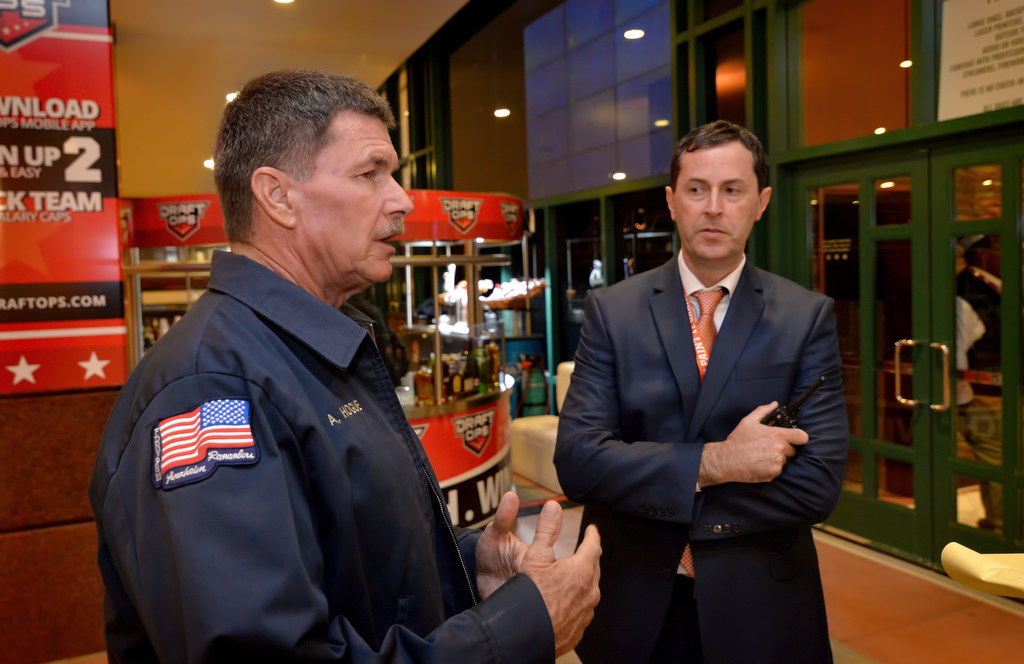
Allen Hogue, acting fire marshal for Anaheim Fire & Rescue, left, talks about his responsibilities at Honda Center and what he looks out for during a walking tour with Quinn Mackin, director of events for Anaheim Arena Management, which oversees management of Honda Center.
Photo by Steven Georges/Behind the Badge OC
It’s gotten to the point where Hogue and Mackin communicate in shorthand, anticipating what things need to be done when a large event rolls into town.
Hockey games are more standard events than concerts, Hogue and Mackin say, with many in the stands return visitors who know the ins-and-outs of Honda Center. Concerts are more complicated, with many visitors new to the arena.
With safety of the crowd their No. 1 priority, Hogue’s and Mackin’s teams take no chances — “standard” event or not.
A half hour before doors opened at 5:30 p.m. before the recent Ducks game, two Anaheim Fire & Rescue inspectors reported to duty.
Two hours before the game started at 7 p.m. and throughout the game, one of the inspectors served as a “roamer” who walked the four concourse levels and peeked inside the arena to inspect “The Bowl,” as he called it, to make sure nothing was amiss.
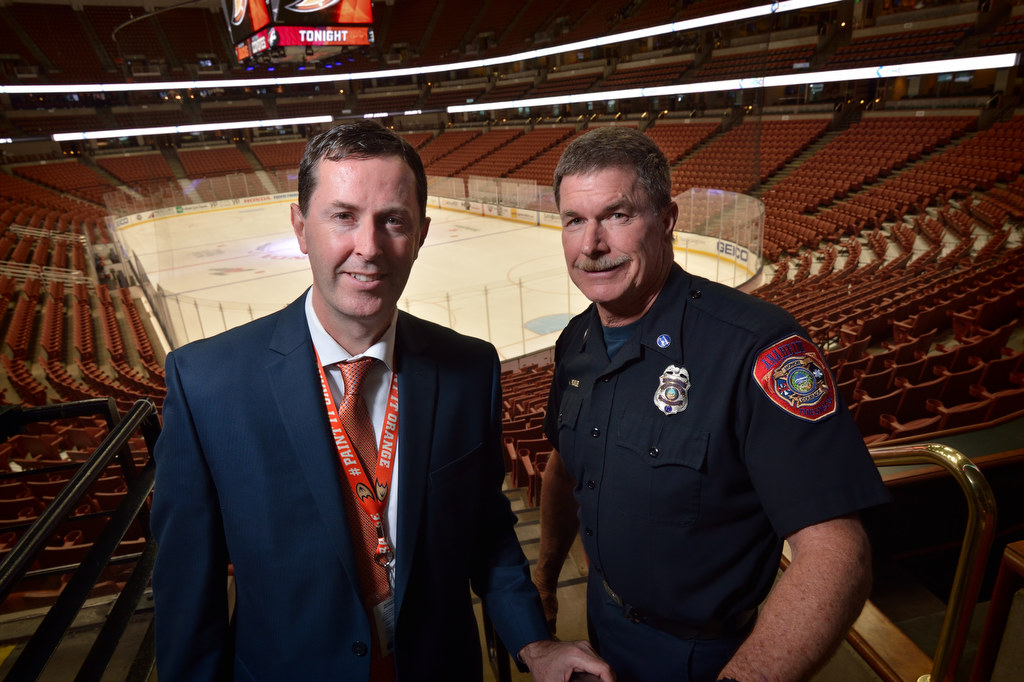
Quinn Mackin, director of events for Anaheim Arena Management, left, with Allen Hogue, acting fire marshal for Anaheim Fire & Rescue, at Honda Center.
Photo by Steven Georges/Behind the Badge OC
The second inspector sat in a room shared by security, keeping his eyes permanently glued to the “fire panel,” which shows, among other things, if an alarm gets triggered.
The two inspectors, throughout the course of the hockey match, traded off duties.
“We try to stay highly visible,” said AF&R Fire Inspector Todd Rudaitis, playing the role of roamer before the recent Ducks/Coyotes contest.
“Four laps around the building is one mile,” Rudaitis noted.
A relatively new task for Rudaitis and other AF&R inspectors was monitoring the flow of the crowd through metal detectors during Ducks games at Honda Center.
Joining the NBA and MLB, the National Hockey League came out with a mandate this season requiring all ticket-holders to walk through metal detectors. Anaheim Fire & Rescue worked with Honda Center management to figure out where best to put the detectors so the crowd could enter the arena safely and efficiently.
Over the years at Honda Center, there have been no major incidents or disasters.
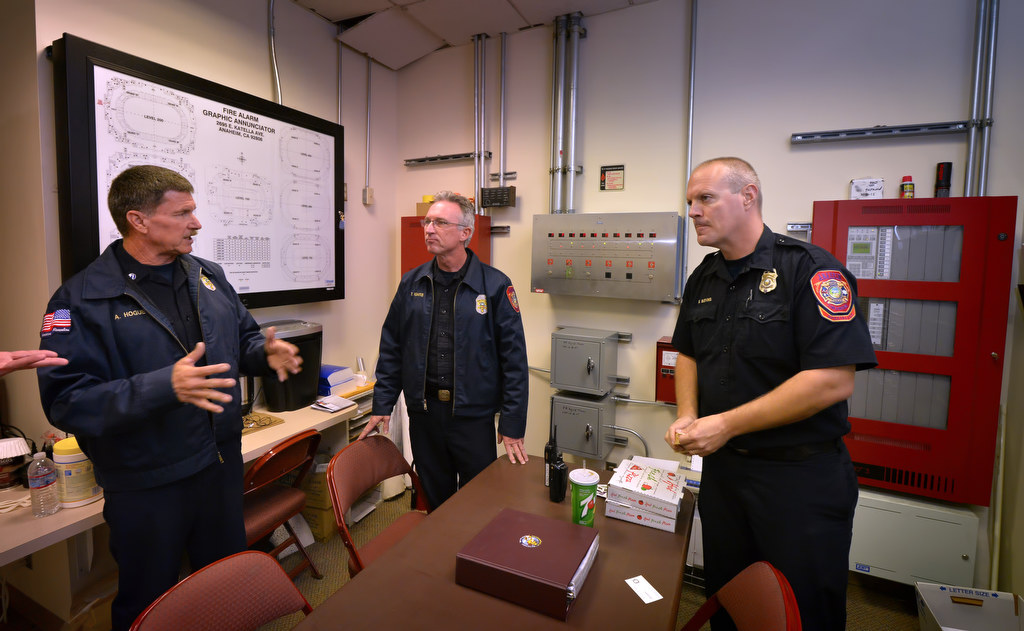
Allen Hogue, acting fire marshal for Anaheim Fire & Rescue, left, talks to Todd Rudaitis, AF&R fire inspector, and Gary Blevins, AF&R hazardous materials specialist II, inside the control room at Honda Center before a Ducks game.
Photo by Steven Georges/Behind the Badge OC
That sterling safety record is a testament to the close working relationship between Anaheim Fire & Rescue and arena management.
A month before an event blows into town — say, a rock concert — Mackin, who works closely with promoters, determines what the event will look like. Then he has AF&R inspectors go over CAD drawings to examine specifics of the production.
What’s the size of the stage?
What about the size of the area where audio and lights will be controlled?
Will the concert involve pyrotechnics?
These are among some of the questions AF&R inspectors get answered before they determine such things as maximum capacity of concertgoers allowed on the floor to how the stage should be arranged.
Over the years, Hogue and Quinn have come up with between 15 and 20 stage layouts that safely can be accommodated on the floor of the Honda Center. The standard rule of thumb for maximum number of general assignments tickets — tickets reserved for fans who stand on the floor and crowd the stage area — is about 1,800, Quinn said.
Hogue, 59, started at AF&R in 1994 as a fire inspector.
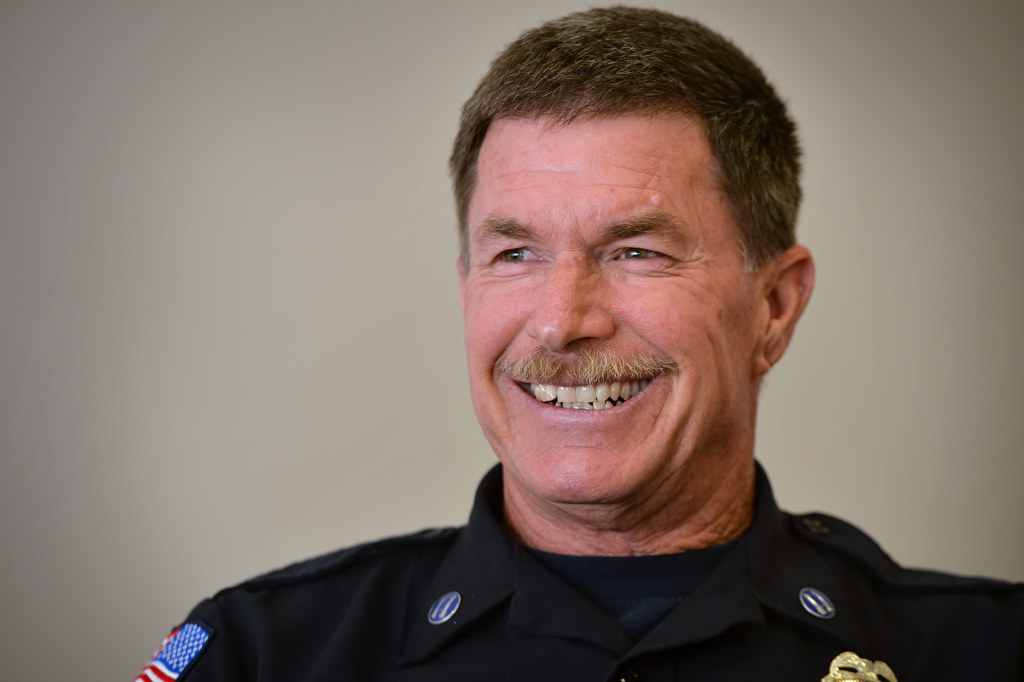
Acting Fire Marshal Allen Hogue of Anaheim Fire & Rescue.
Photo by Steven Georges/Behind the Badge OC
His 21 years of experience has made him an expert at making sure buildings, and homes, in Anaheim are safe. Hogue was named acting fire marshal upon Jeff Lutz’ retirement last month (see related story).
“You’ll find my signature on a lot of building cards around this city,” Hogue said, referring to the forms he signs that are stored digitally that show building plans that have received his endorsement.
Seven fire inspectors work for Hogue.
In addition to checking building plans, the team oversees such programs as AF&R’s Home Safety Visit Program, in which inspectors check to make sure smoke alarms are working in homes. Residents can sign up to have an inspector come out and make sure their alarms are functioning.
With a host of new construction going on in Anaheim, Hogue and his team are busier than ever. Currently there are 700 residential units and five high-rises (seven stories or more) under construction in the city, he said.
The fire inspectors check on such things as making sure fire sprinklers, fire alarm and egress requirements are met per current codes.
A typical new high rise can take one inspector about 15 hours to examine, Hogue said.
Hogue, who was born in Downey and grew up in Huntington Beach, for years worked in construction before entering the fire service. He is a former lifeguard and avid surfer.
He’s also an eagle eye when it comes to checking on the safety of buildings — his radar rarely turns off, even when he’s not working.
“My wife tells me all the time to turn it off,” Hogue said. “We’ll be out having dinner, and I’m sitting there making sure the exit signs are lit, looking for the occupant load sign, checking the hardware on the doors.
“It’s like my head is on a swivel; I can’t turn it off.”
For residents and workers of Anaheim, and visitors to Honda Center, that’s a good thing.
 Behind the Badge
Behind the Badge

